MARIANI’S
November
4, 2007
NEWSLETTER
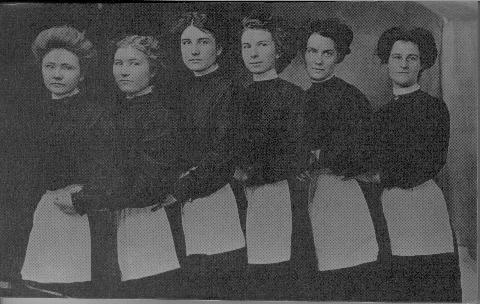
The Harvey Girls of The Harvey House Restaurants, 1905
NEW! Click esquire.com
to go to my new biweekly column at Esquire
Magazine.
ARCHIVE: Readers may now access
an
Archive of all past newsletters--each annotated--dating back to July,
2003, by simply clicking on www.johnmariani.com/archive
SUBSCRIBE AND
UN-SUBSCRIBE: You may subscribe anyone you wish
to this newsletter--free of charge--by
clicking here.
In
This Issue
TO GET AWAY FROM IT ALL, HEAD SOUTH OF CANCUN by John Mariani
NEW YORK CORNER: Arabelle by John Mariani
NOTES FROM THE WINE CELLAR: Three Decades of Lehmann Shiraz by John Mariani
QUICK BYTES
TO GET AWAY FROM IT ALL, HEAD SOUTH OF CANCUN
by John Mariani
 here, gobbling up the
buffets, oiling themselves on the
sand, sloshing around in the pools, and slurping cloyingly sweet
piña coladas while splayed on a chaise longue. I'm told
one of the big local
thrills in Cancun is to pay 250 pesos to swim with the parrot fish.
Glub,
glub.
here, gobbling up the
buffets, oiling themselves on the
sand, sloshing around in the pools, and slurping cloyingly sweet
piña coladas while splayed on a chaise longue. I'm told
one of the big local
thrills in Cancun is to pay 250 pesos to swim with the parrot fish.
Glub,
glub.The Ritz-Carlton Cancun
One of the few oases of luxury and sophistication, however, is the Ritz-Carlton (Retorno del Rey #36, Zona Hotelera; Phone: 52 998 881 0808), whose architect cannily arranged its U-shaped wings to block out the sight of other, less attractive hotels on the strip. The Ritz has two good restaurants here, the casual El Café Mexicano and the more formal Club Grill.
If you head south of Cancun, down the broad Highway 307, along what is called the Mayan Riviera, whose landscape is quickly filling up with more huge resorts and spectacular homes and condos, you can still have a true sense of getting away from it all. But hurry, development is rampant.
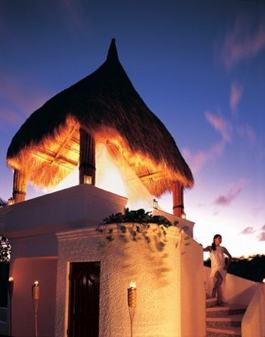
Maroma Resort and Spa
Carretera 307, Km 51
Riviera Maya, Solidaridad, Quintana Roo
Tel: 52 (998) 872 82 00
www.maromahotel.com
One of the most reclusive places off 307 is Maroma Resort and Spa, 25 miles south of the airport and worlds away from the vulgar bustle of Cancun.
The resort, spread over 25 acres, is set down a bumpy road from the highway, and once inside you realize you are in the leafiest of environments, with whitewashed stucco buildings and casitas with thatched roofs, all facing an extraordinary expanse of blindingly white sand and restless blue sea. There are 65 rooms and suites decorated in bamboo and polished mahogany, with king size beds, and fine big bathrooms. And each has a hammock whose seductive swaying could keep you in it for hours on end, reading, napping, or just wondering about the world far away. Or you could drive 45 minutes to the Mayan ruins of Tulum and get in touch with the sun gods.
I should comment that the service here is exceptional, especially among the young, well-trained, English-speaking reception staff, who, during a disastrous halting of flights out of Cancun because of stormy weather in the States, did everything possible for every anxious guest, including me, both to make the best possible arrangements and to calm the flustered feathers of a very demanding clientele.
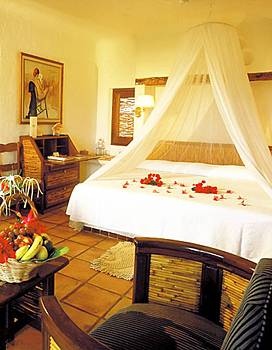
There are two principal eating venues here, the evocative dining room El Sol and the more casual El Restaurante, which spills out onto the patio and beach.
El Sol (below) is where chef Guillermo Javier Gomez is doing some superlative work, incorporating Mayan culinary traditions into his own modern ideas, utilizing, as much as possible, the local provender. The arched ceiling of the semi-round dining room is draped with fabric, and you sit watching the sunset at a commodious, well-set table, ministered to by a very affable, English-speaking staff.
We began out dinner at El Sol with a trio of tuna renditions and followed with an entrada of King crab with jicama tacos, a cucumber and tomato confit salad, dressed with hibiscus vinaigrette. Excellent indeed was a charming take on a downhome item, the chimichanga--filled with a foie gras parfait. Our main courses were a lovely, very fresh (not always a given in the Caribbean) red snapper with radish and spicy jalapeño, with a watercress relish over annato-colored yellow risotto and smoked tomato coulis; the
 other was a somewhat fussy but
very good loin of venison crusted with coffee and ancho chile, and
venison barbacoa (barbecued),
with black bean mousseline and sautéed Brussels sprouts. Our
desserts included a fine plantain soufflé with a chocolate bon
bon and herb salad--an interesting idea well realized--and "bocanegra" an oddity of tomato
confit, black olive syrup, lime ice cream, and basil foam that was
better than it sounds.
other was a somewhat fussy but
very good loin of venison crusted with coffee and ancho chile, and
venison barbacoa (barbecued),
with black bean mousseline and sautéed Brussels sprouts. Our
desserts included a fine plantain soufflé with a chocolate bon
bon and herb salad--an interesting idea well realized--and "bocanegra" an oddity of tomato
confit, black olive syrup, lime ice cream, and basil foam that was
better than it sounds.Appetizers at El Sol range from $22-$38, main courses $25-$40.
We did not find during our visit much to recommend at El Restaurante, all all-day eatery whose menu--something for every tourist--almost seemed an afterthought to the carefully crafted dishes of El Sol. Nor was the service here much beyond the rudimentary. The various breakfast omelets with Mexican ingredients are dependable, the lunch pizza terrible. Suffice it to say that the food was not untypical of Caribbean resorts or those up in Cancun, except for Maroma's delightful Mexican señora (right) who makes fresh tortillas at the side of the restaurant and brought them warm to your table, smelling and tasting of roasted corn.

An emphasis on the Spa at Maroma is not uncalled for. Named Kinan, the Mayan word for "energy of the sun," the spa, which is built according to Mayan "Sacred Geometry," offers a open-air massage palapa tower with a 360-degree view. It is exceptionally beautiful, with a jantzu garden pool, and several treatment rooms. After being worked on, you can try to feel even more healthful by having a lunch of Spa Cuisine here, but I found nothing abou it worth the few calories lurking in the food.
Seclusion is a big part of the draw here, and, because it doesn't have a large number of guestrooms--just 64--you pretty much have the run of the place and the average square footage you have all to yourself at the beach probably exceeds most people's backyard.
Photo by Galina Stepanoff-Dargery

www.tidesrivieramaya.com
I can't imagine why the new owners, the Kor Hotel Group, changed the wonderfully sublime and evocative Mayan name of "Ikal del Mar" to the far more mundane and less appealing The Tides, which evokes something more like a chain motel in Pensacola than it does the Mexican Riviera. Nevertheless, the unique beauty of this highly hidden resort is still wholly intact, and constantly being improved upon.
With only 30 villas, each sequestered deep in a jungle you must wend your way through, you're not likely to be tripping over other guests. In fact, it took me two days just to become familiar enough with the pathway to my own villa: You have to make up your own signposts--a big guava tree, a yellow umbrella, a curve in the pathway--that's how secluded things are here. You can even take a shower outside your villa and no one will ever know, so dense is the foliage around you. And you get your own private plunge pool, 12 to 14 generous feet in length.
There are no motorized vehicles whatsoever at The Tides once beyond the entrance, and all you do is sign a guestbook in order to check in--none of that five minutes' of computer typing that makes one's arrival in most places less than welcoming. You also need not sign any guest bills during your stay.
There is, of course, the yoga studio and requisite spa here--Temazcal, a beach-side Maya-style sauna, a sweat lodge, with massage rooms in which you listen to "chants and prayers to cleanse holistically the body, spirit and mind." Whatever.
The villas seem entirely yours, palapa-roofed, with louvered-mahogany doors and windows, sisal rugs, and canopy beds spread with Egyptian cotton linens. Cell phone service is non-existent, although a computer hook-up is. And there are DVD and CD players in the room, if you've had enough sun and foliage. No children under 16 are permitted. So if total indolence is your preference on vacation, The Tides is ideal; if, however, you wish to visit the Mayan ruins in the era--Tulum is the closest--there is that, too, along with all the usual sporting activities.
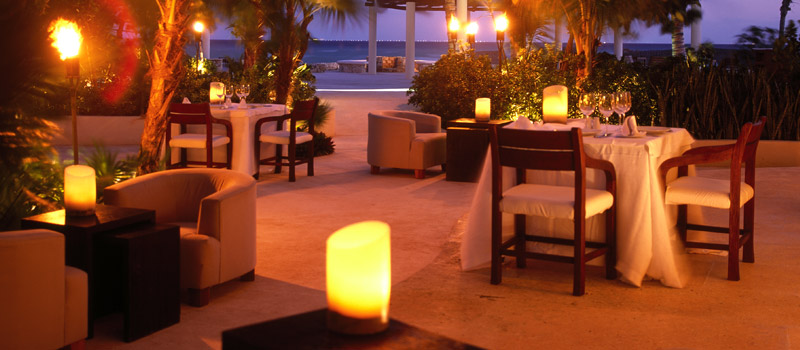 The
resort also offers a "dine anywhere" option, but the lovely Riviera
Maya restaurant and cocktail lounge, (left)
fronting the sea, is an enchanting
way to spend an evening at twilight. When I was there I also had a
chance to indulge in a tasting of Mexican wines--they stock more than
500 labels of all kinds--and one of the most
delightful ways to dine here is at a beach barbecue. Yet another option
is to take a cooking class with the resort's chef, held outdoors next
to the "cooking spot"--a thatched hut with a hot rocks-heated pit in
which the food is placed and covered with banana leaves. This was
really a wonderful and unique experience.
The
resort also offers a "dine anywhere" option, but the lovely Riviera
Maya restaurant and cocktail lounge, (left)
fronting the sea, is an enchanting
way to spend an evening at twilight. When I was there I also had a
chance to indulge in a tasting of Mexican wines--they stock more than
500 labels of all kinds--and one of the most
delightful ways to dine here is at a beach barbecue. Yet another option
is to take a cooking class with the resort's chef, held outdoors next
to the "cooking spot"--a thatched hut with a hot rocks-heated pit in
which the food is placed and covered with banana leaves. This was
really a wonderful and unique experience.I would like to say more about the quality of the cuisine at the Riviera Maya, but the current chef came to the resort several weeks after I visited. Suffice it to say that he is said to be cooking much in the style of his predecessor, updating Mayan food, albeit post-Columbus when the Spaniards had the good sense to bring in pigs and cattle to Mexico. Glance at the menu at the restaurant and you'll get a pretty good sense of the kind of food I was very happy to feast on here.
Las Ventanas
Royal Hideaway Playacar
1-800-999-9182
www.royalhideaway.com
Having recently met young Spanish star chef Sergi Arola, whose Madrid restaurant La Broche is considered one of the finest in the country, I made a special trip to dine at the restaurant he oversees at the huge
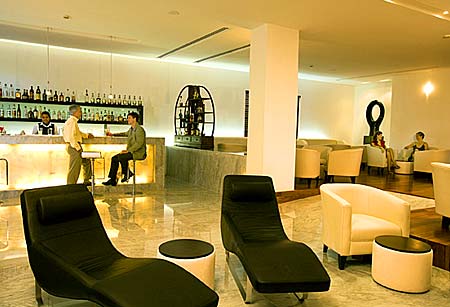 Royal Hideaway Playacar, which is near the hip boomtown
Playa del Carmen. The resort itself is pretty spectacular, spread
over 13 acres, with villas, winding pathways, and an oceanfront whose
beach was much damaged and not completely back to normal since
Hurricane Wilma ploughed through the region in 2005.
Royal Hideaway Playacar, which is near the hip boomtown
Playa del Carmen. The resort itself is pretty spectacular, spread
over 13 acres, with villas, winding pathways, and an oceanfront whose
beach was much damaged and not completely back to normal since
Hurricane Wilma ploughed through the region in 2005. The villas' rooms are splendid, sumptuously decorated, and quiet, though the whole place has the look of a tourist package deal, and, unlike Maroma and The Tides, is anything but secluded.
My wife and I had a pleasant enough light lunch at the casual Mexican restaurant here, Spices, waiting to be amazed at Arola's restaurant, Las Ventanas, that evening. We were very happy with the modern, handsome look of the latter, not least the sexy, backlighted bar area (right). In the dining room (below), which seats a judicious number of 50, there is a beautiful wall of wine behind glass and a pianist who plays romantic ballads throughout the evening. Tables were well set and well spaced, the service staff fairly well trained (one waiter sought to remove a wineglass still half full), the winelist good. Unfortunately people come here dressed as if they'd just gotten off the beach, which detracts from the cool elegance of the place. The staff should also pay attention to the a/c: It was 82º F in the room when we dined.
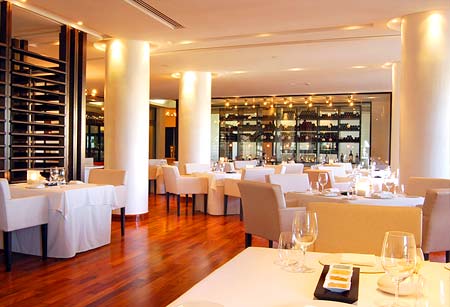 Opening the menu we were tantalized by the simple
descriptions of what sounded like highly creative cuisine. Arola,
like most consulting chefs in the world, was nowhere to be seen. Our
first taste of a crab soup with vegetables and mascarpone ice cream was
typical of, and very good, Arola's style, which always has a little
surprise in the simplicity of conception. An appetizer was described as
"cubes of confit potato in a brava and ali-oli Style," and that's all
they were--a very few cubes of potato with a mild olive oil dressing,
more like a nibble than a course. Grouper and tuna salad with a creamy
cod and almond soup (and unmentioned anchovies) was tasty, if not
marvelous.
Opening the menu we were tantalized by the simple
descriptions of what sounded like highly creative cuisine. Arola,
like most consulting chefs in the world, was nowhere to be seen. Our
first taste of a crab soup with vegetables and mascarpone ice cream was
typical of, and very good, Arola's style, which always has a little
surprise in the simplicity of conception. An appetizer was described as
"cubes of confit potato in a brava and ali-oli Style," and that's all
they were--a very few cubes of potato with a mild olive oil dressing,
more like a nibble than a course. Grouper and tuna salad with a creamy
cod and almond soup (and unmentioned anchovies) was tasty, if not
marvelous.Portion size is a problem here: We had a very small amount of lobster with stewed arborio rice and garlic ice cream , and what was described as "Angus Roast Beef with a Foie Gras Ice Cream and Aniseed Salad" (the ice cream conceit was getting a bit conceited), which was a few small slices of cold roast beef with what might in lesser places be called gravy. It was truly a dull dish.
Desserts weren't much better--ridiculously tiny thimbles of confit carrots with yogurt and pistachio praline, and a mediocre version of the ubiquitous soft-centered chocolate soufflé "in the idea of a Black Forest," whatever that means.
I was disappointed pretty much with everything and wondered--not for the first time--why great chefs put their names on restaurants they really have no way on controlling unless they commit to a rigorous schedule of visitations.
NEW YORK CORNER
by John Mariani
ARABELLE
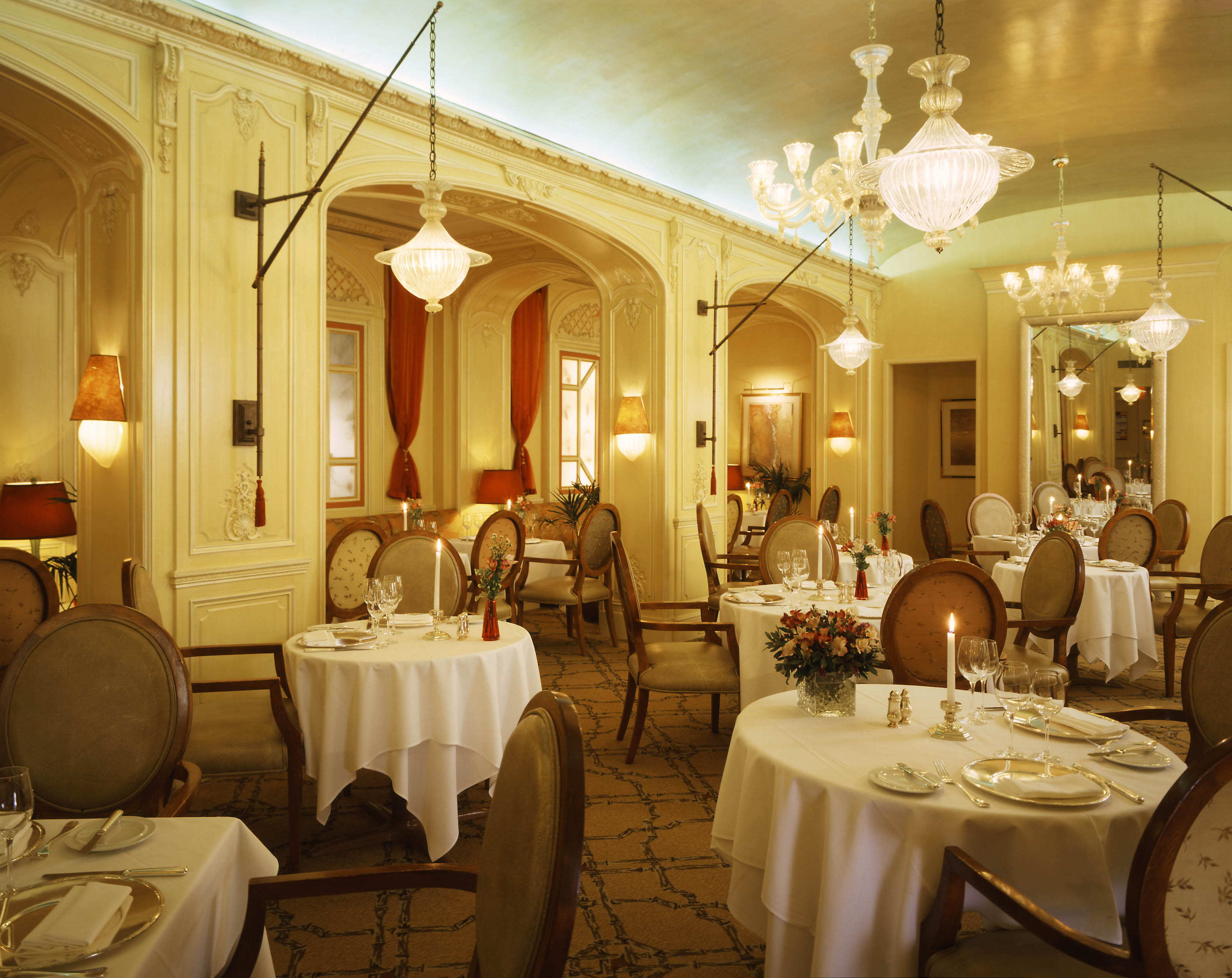
Hotel Plaza-Athenée
37 East 64th Street
212-606-4647
This may well be the case with Arabelle, sequestered in the posh Plaza-Athenée Hotel, whose own occupancy, despite room prices of $695 and up, is near full most nights of the year. Despite Arabelle's being very fine and French, the new Michelin Guide 2008 to NYC doesn't even include it. Yet Arabelle is one of the loveliest restaurants in
The decor was changed a while back from a rococo Valerian Rybar flamboyance, complete with painted cloudy skies, to a warm setting of fin-de-siècle moldings and arched columns that provide cozy banquette seating. That ceiling is now a glowing silvery-gold reflecting the light of glass chandeliers. The tables are impeccably, richly set with heavy linens and fine glass and silverware, fresh flowers and candles, and the tables themselves are wonderfully spacious.
 Before you ever get to the dining room,
however, you must pass from the hotel lobby through the Bar Seine (left), a sexy,
shadowy place that begs the word soigné. The night I
visited the place was hopping--or seated--with a bevy of people who
might very well have been just off the plane from Charles de Gaulle or
whipped in from St. Bart's.
Before you ever get to the dining room,
however, you must pass from the hotel lobby through the Bar Seine (left), a sexy,
shadowy place that begs the word soigné. The night I
visited the place was hopping--or seated--with a bevy of people who
might very well have been just off the plane from Charles de Gaulle or
whipped in from St. Bart's.At Arabelle Chef Ike Koutrakos works his menu to please but not to pander. It is just as American as it is French, as are most deluxe menus, even in Paris, these days. I suppose if you asked him for a filet mignon well done, he'd do it, but that would be a wave-off to one of the most interesting young chefs in New York right now.
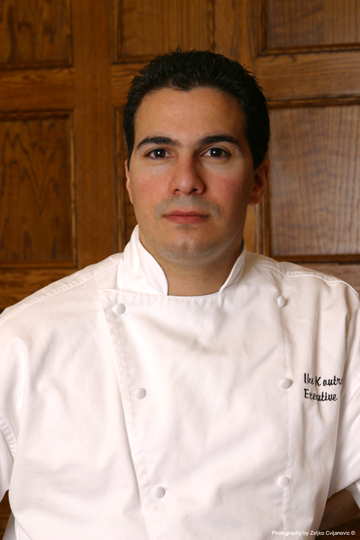
We began with a glass of Ruinart Brut Rosé, chosen by food and beverage director Martin Magdeburg, to go with a trio of ahi tuna bites--sashimi with yuzu vinaigrette and daikon, a tartare with luscious avocado mousse and a dot of osietra caviar, and seared, rare tuna with a sesame seaweed salad. Butter poached lobster came with white corn grits (no Franglais here), shavings of truffles, and smoked paprika-scented "Niblets," with tidbits of seared pork belly and a chicken jus, all of which added up to a very impressive starter. Sea scallops were gently roasted and served with a cranberry purée with tomato confit and dressed with a vinaigrette, a dish of tangy-sweet notes to cuddle the creamy flavor of the scallops. Seared foie gras with a pear roasted with vanilla and served with a brandied pear coulis was a delightful dish, and a ragoût of rabbit was braised with citrus and accompanied by wheat germ pasta with a pecorino gremolata. With these starters we drank a fine Franciscan Cuvée Sauvage Chardonnay 2005.
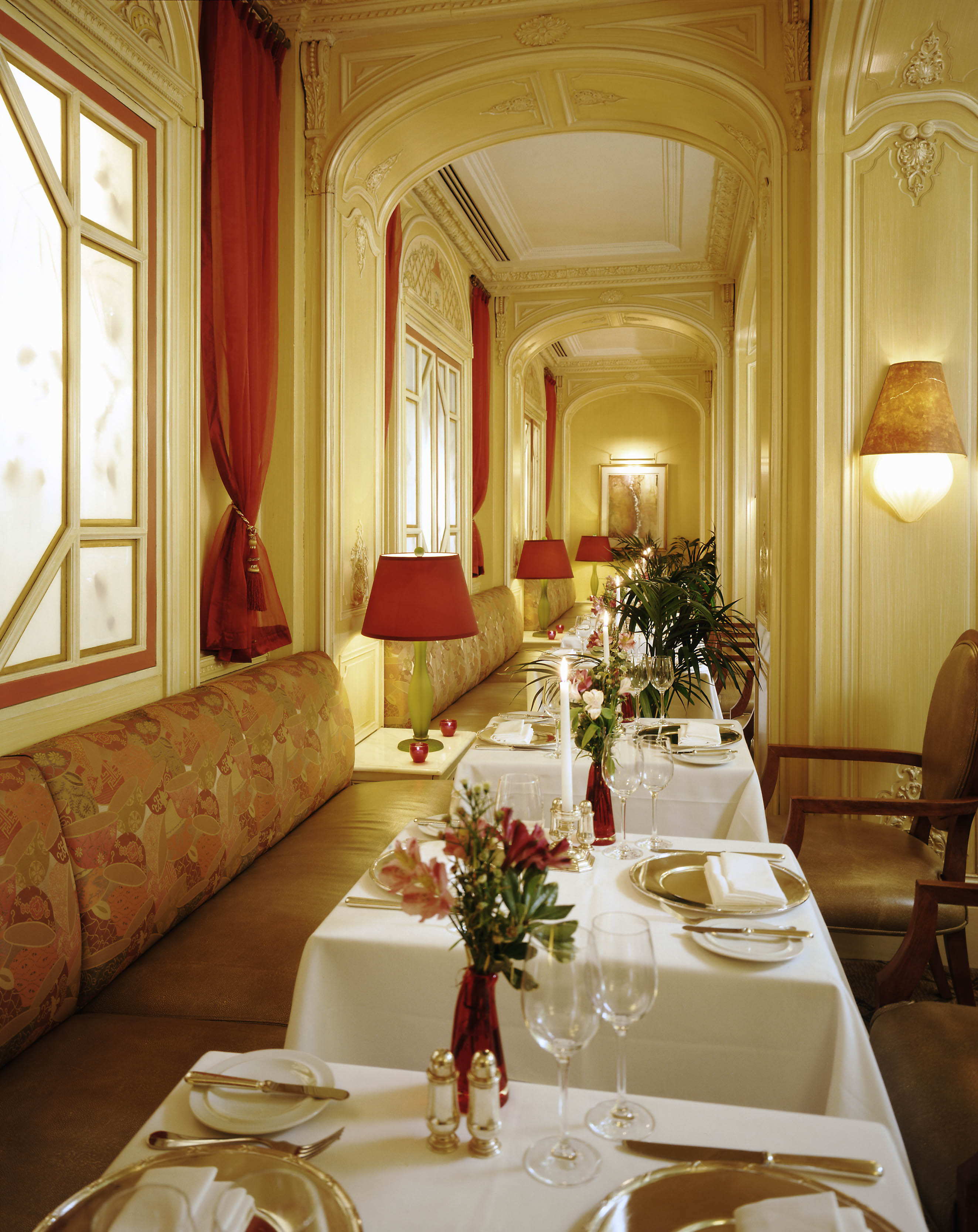 A Hamilton Russell Pinot
Noir 2004 from Walker Bay, South Africa, was a complete surprise to me,
and it alerted me to just how well that varietal is doing in that
up-and-coming region. It went exceptionally well with
maple-glazed duck breast
with roasted yams, okra spiked with cayenne pepper, and a red wine
sauce, as well as with a terrifically flavorful rack of lamb, perfectly
fatted around the edge, served with a fricassée of wild mushroom
and roasted tomato, sautéed sunchokes, and truffled persillade. The red wine also went well with juicy
pan-seared
A Hamilton Russell Pinot
Noir 2004 from Walker Bay, South Africa, was a complete surprise to me,
and it alerted me to just how well that varietal is doing in that
up-and-coming region. It went exceptionally well with
maple-glazed duck breast
with roasted yams, okra spiked with cayenne pepper, and a red wine
sauce, as well as with a terrifically flavorful rack of lamb, perfectly
fatted around the edge, served with a fricassée of wild mushroom
and roasted tomato, sautéed sunchokes, and truffled persillade. The red wine also went well with juicy
pan-seared Desserts, by Lauren Ragone, were every bit as inventive as the other courses and included an "Autumn Trio Tasting Plate
Arabelle's winelist, overseen by maître d' and sommelier Romano Chiazzo, holds 231 selections and 850 bottles.
Dining in a room as lovely as this on cuisine prepared with obvious care and respect for ingredients by a young chef determined to make his mark through due diligence rather than spectacle means that you will have a civilized meal, good conversation with your friends, deftly poured wines, and be reminded that the antiquated frou-frou that once marked hotel dining rooms was never actually a true mark of elegance. Arabelle sets the proper tone for a modern hotel restaurant where you will feel just as cosmopolitan as you fancy yourself to be.
The 3-course dinner menu at Arabelle is $74.
NOTES FROM THE WINE CELLAR
A Thirty-Year Retrospective of Peter Lehmann Shiraz
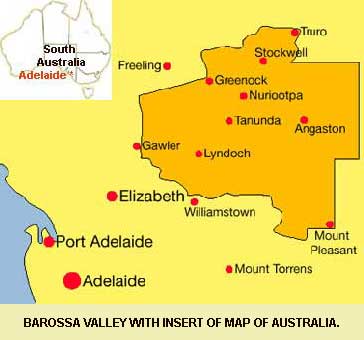 Since
no more than a handful of Australian
wineries in the Barossa Valley date back more than 20 years, it was a
unique
event to taste 30 vintages of Shiraz from a single estate, Peter Lehmann
Wines at a lunch for wine
media, sommeliers, and retailers at The
Modern in New York.
Since
no more than a handful of Australian
wineries in the Barossa Valley date back more than 20 years, it was a
unique
event to taste 30 vintages of Shiraz from a single estate, Peter Lehmann
Wines at a lunch for wine
media, sommeliers, and retailers at The
Modern in New York.Peter Lehmann, 76, the fifth generation Barossan who started his wine career in 1947 near Tanunda, north of Adelaide, and his son Douglas is now managing director. Over the last six decades the company has grown to produce 500,000 cases under the Lehmann label; another 4.5 million liters of grape juice is sold off to other wine producers. About 60 percent is exported, mostly to the EU and Great Britain. The U.S gets 66,000 cases, less than 10 percent. Switzerland’s Hess Group now owns 86 percent of Lehmann; Lehmann itself retains 11 percent, and the last 3 percent is owned by 410 Barossan grape growers, farmers, and local tradesmen.
Yet when Lehmann (below) founded his winery, Australia’s wine industry was in a sad state, dominated by a British and local taste for fortified and sweet wines. The government was even offering money to grape growers to rip out their vines and plant different crops. Lehmann had to guarantee more than 150 growers he would buy their grapes if they grew them. The growers’ loyalty has ever since been one of the company’s strongest suits in good and bad times.
Not until the 1980s did Australia’s modern wine industry get into gear. Today the country is the world’s sixth largest producer and fourth largest exporter, with about 2,000 wineries making more than 350 million gallons of wine annually, and sales of more than $2.5 billion in sales. Today less than one percent of wines are fortified. Forty percent of all wines are exported, and United Kingdom and the U.S. absorbing 70 percent of it.
Shiraz has long dominated the Australian wine market, with some vines dating back 150 years. Today Shiraz represents 24 percent of total grape production. The problem has been that the varietal has taken on several styles, not least the popular, heavily extracted, high alcohol Shirazes embraced by the wine media and importers since the 1990s.
The opportunity, then, to taste three decades of Shiraz from the same company was really a history lesson in how the varietal has been pressed into service for a global market.
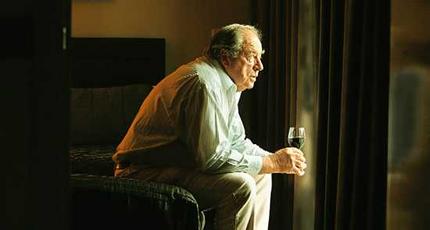
As Lehmann’s winemaker, Ian Hongell, noted at the luncheon, "There are vineyards that history tells us to watch closely, [because they are] tended by the same family for generations. These old, low-yielding vineyards are located in the harder country of the Barossa, where rainfall is sparse. Mother Nature allows only the strongest to survive so than the fruit carries with it presence and pedigree.”
What impressed me most was the consistency of flavor in the Lehmann Shirazes, even though some were far past their prime and others sadly oxidized. The 1980 vintage was made while the winery was still being built, with wine spilling onto freshly laid cement. There were drought years in the early ‘80s, followed by the “Flood Year” of 1983, when barrels floated away down the river.
The Lehmann style really began to show itself in the late 1980s, with fruit vibrant, color a nice ruby-purple, and very easy to drink while fairly young. By the ‘90s there was more concentration, at a time when, said Hongell, “we had some brand new technological toys for analysis of the grapes and their juice.”
Alcohol levels began to creep up from 12.5 in 1986 to 14.5 percent in 2002, though Hongell insisted “We make wines that are more about texture—not jammy flavors or alcoholic sweetness”—a style other Australian Shirazes have had success with.
Starting with the 1994 vintage, the wines revealed more and more complexity and a distinctive Aussie Shiraz flavor in contrast to the denser, more tannic Syrahs of France’s Rhone Valley. The Lehmann wines show an abundance of ripe (not over-ripe) fruit, sunny big wines ideal for grilled meats. As of 1998 they began to develop a brawny backbone and a long finish. The most interesting vintage was the 2000, which smelled of the sea, briny, with a salty-anise flavor, and from 2002 on, the wines had exceptional balance, rich cherry-like fruit, and a lush explosion of flavors on the palate.
 After the formal tasting we sat down
to a
lunch by chef Gabriel Kreuther, accompanied by two more of Lehmann’s
most
prestigious Shiraz bottlings. The Eight Songs 2002 ($60), from the
coolest
Barossa vintage on record, was matured in wood for 18 months. It’s a
huge wine,
destined to get better and better over the next decade. Hongell, who
has a
talent for eccentric Aussie metaphors, called it “feminine but
formidable, like
Halle Berry.” Of a Stonewall 2002 ($100; left), a massive, chewy Shiraz that
went
through a slow-ripening summer and fall, Hongell mused, “Right now it
tastes
like buckets of bolts and nails and ground-up tractors, a Russell Crowe
of a
wine.”
After the formal tasting we sat down
to a
lunch by chef Gabriel Kreuther, accompanied by two more of Lehmann’s
most
prestigious Shiraz bottlings. The Eight Songs 2002 ($60), from the
coolest
Barossa vintage on record, was matured in wood for 18 months. It’s a
huge wine,
destined to get better and better over the next decade. Hongell, who
has a
talent for eccentric Aussie metaphors, called it “feminine but
formidable, like
Halle Berry.” Of a Stonewall 2002 ($100; left), a massive, chewy Shiraz that
went
through a slow-ripening summer and fall, Hongell mused, “Right now it
tastes
like buckets of bolts and nails and ground-up tractors, a Russell Crowe
of a
wine.”These last two wines are Lehmann’s big show pieces, and priced accordingly. But the company has really made its reputation on more moderately priced Shiraz, which range from $13 to $30, with special bottlings like the Eight Songs and Stonewall higher.
The tasting showed how the evolution of Shiraz, and Australian wines in general, passed through a shaky infancy into global prominence, even if much of the cheap, prune-sweet Shiraz coming out of Australia is not worth drinking at any price.
When I asked Peter Morrell of New York’s Peter Morrell wineshop, who attended the tasting, if his customers buy the cheap Aussie Shiraz “No,” he said. “I have trouble selling $9 bottles of Australian red wine, but not these.”
John Mariani's weekly wine column appears in Bloomberg Muse News, from which this story was adapted. Bloomberg News covers Culture from art, books, and theater to wine, travel, and food on a daily basis, and some of its articles play of the Saturday Bloomberg Radio and TV.
THOUGH IT’S NOT A
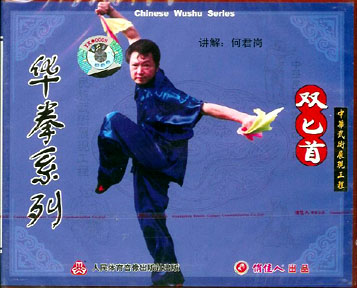
ACTUALLY WHAT HERACLITUS DID SAY WAS, “IN ATHENS A
MAN CAN EAT THE SAME TWO
DISHES
A THOUSAND  TIMES .”
TIMES .”
“A venerable bit of wisdom
from the Greek sage Heraclitus teaches that you can never step in the
same
river twice, for neither you nor the ceaselessly flowing river remains
the
same. Your odds are better at restaurants, which also change, though
not quite
ceaselessly. (I am extrapolating from Heraclitus here; if the man ever
made
remarks about restaurants, posterity has forgotten them.) Crowds come
and go,
of course — but decor and menu can remain little changed for months or
even
years. In a restless culture, such stability can seem boring or even
slightly
sinister, a dawdling on the way to some new and improved destiny. Yet
there are
those of us who like our points of reference.”—Paul Redinger, “Destino:
Destiny's
house,” San Francisco Bay Guardian (
QUICK BYTES
TO ALL PUBLICISTS: Owing to the amount of material sent to this newsletter regarding Thanksgiving, Christmas, and New Year's dinners--many of which are only announcements as to price fixed dinners--it is impossible for me to include any but the most unusual of events for those holidays in Quick Bytes. --John Mariani
* In
* On Nov. 13 NYC-based Gruppo Ristoratori Italiani (GRI) will hold its consumer tasting “Vino e Cucina,” at Cipriani 23rd Street, presenting Italian delicacies and signature dishes paired with the best Italian wines and spirits, plus a wide range of auction items, ranging from vacation getaways to Italy to unique dining and wine experiences in NYC. Some of the restaurants incl: NYC—San Domenico
* On Nov. 13 Benoit Cornet will demonstrate the art of at home mixology at Sanctuary T in NYC as part of the inaugural meeting of the monthly Cocktail Club demonstration and tasting, scheduled to meet on the second Tuesday of each month. Attendees will sample 3 cocktails, be given
* On Nov. 15 Chefs Gayle Pirie and John Clark of Foreign Cinema in
* On Nov. 16 SWEET, presented by Ferrero Rocher, a late night dessert party for 1,500 guests at The Waterfront, featuring Food Network stars and creations by NYC’s premier pastry chefs, chocolatiers, bakers, and confectioners, complemented by great wines, Champagnes and spirits from the Southern Wine & Spirits of NY. To benefit the Food Bank For NYC and Share Our Strength. Visit www.nycwineandfoodfestival.com.
* On Nov. 15 a
* On Nov. 15 in Chicago, Cafe Matou heralds Cru Beaujolais picked by Wine Director James Rahn, served by the glass, as well as menu specials by Chef Charlie Socher. Call 773-384-8911.
* From Nov. 15-18 the Fairmont Newport Beach, CA, will host The American Cheesemaker Awards, featuring tastings, cheese seminars, cooking classes, an awards ceremony and gala dinner, bringing together 40 cheesemakers, cheese experts, chefs, winemakers and specialty food purveyors from around the country to rate 200 cheeses. Tickets to the Awards Dinner and Cheese Tasting are available at Bristol Farms in
* From Nov. 16-25 in NYC, Dévi will be offering a 5-course "Diwali: Hindu Festival of Lights" Tasting Menu paired with wines in honor of the goddess of good fortune. $125 pp. Call 212-691-1300; www.devinyc.com.
* From now through December, Spiaggia in Chicago is offering an 8-course Degustazione di Tartufi
* In
Everett Potter's Travel Report:
Tennis Resorts Online: A Critical Guide to the World's Best Tennis Resorts and Tennis Camps, published by ROGER COX, who has spent more than two decades writing about tennis travel, including a 17-year stretch for Tennis magazine. He has also written for Arthur Frommer's Budget Travel, New York Magazine, Travel & Leisure, Esquire, Money, USTA Magazine, Men's Journal, and The Robb Report. He has authored two books-The World's Best Tennis Vacations (Stephen Greene Press/Viking Penguin, 1990) and The Best Places to Stay in the Rockies (Houghton Mifflin, 1992 & 1994), and the Melbourne (Australia) chapter to the Wall Street Journal Business Guide to Cities of the Pacific Rim (Fodor's Travel Guides, 1991). Click on the logo below to go to the site.
~~~~~~~~~~~~~~~~~~~~~~~~~~~~~~~~~~~~~~~~~~~~~~~~~~~~~~~~~~~~~~~~~~~~~~~~~
MARIANI'S VIRTUAL GOURMET NEWSLETTER is published weekly. Editor/Publisher:
John Mariani. Contributing Writers: Robert Mariani, Naomi
Kooker, Kirsten Skogerson, Edward Brivio, Mort
Hochstein, Suzanne Wright. Contributing
Photographers: Galina Stepanoff-Dargery, Bobby Pirillo. Technical
Advisor: Gerry McLoughlin.
Any of John Mariani's books below
may be ordered from amazon.com by clicking on the cover image.
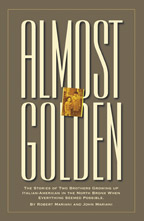 My
newest book, written with my brother Robert Mariani, is a memoir of our
years growing up in the My
newest book, written with my brother Robert Mariani, is a memoir of our
years growing up in the For those of you who don't think of the Robert and I think you'll enjoy this very personal look at our --John Mariani |
 |
 |
 |
 |
 |
 |
copyright John Mariani 2007

